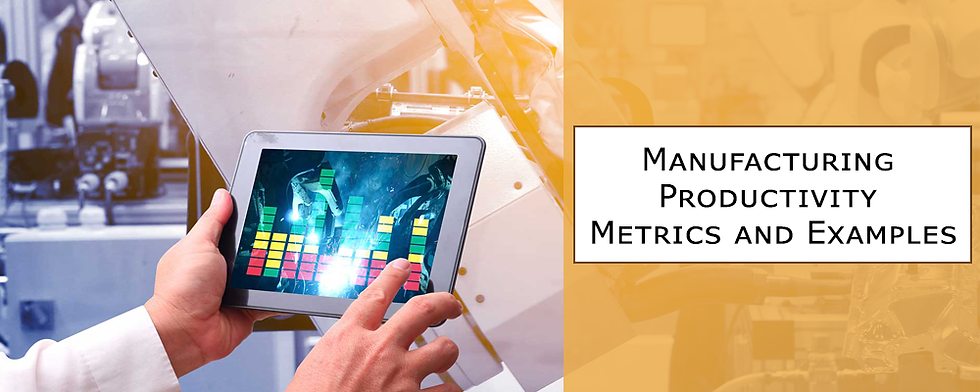Productivity Metrics - How To Effectively Measure Productivity
- The Productive Hack

- May 8, 2024
- 5 min read
Updated: Aug 1, 2024
Productivity metrics are tools we use to measure the efficiency and effectiveness of various business operations. They help us understand how well individuals, teams, and companies perform their tasks. These metrics take into account the amount of work completed and the resources used.

Measuring productivity is crucial for any business, directly impacting profitability and growth. By tracking these metrics, organizations across industries—whether in manufacturing, healthcare, or retail—can pinpoint where they excel and where they need improvement.
This leads to better decision-making, more efficient processes, and enhanced overall performance. Understanding and utilizing productivity metrics effectively ensures businesses stay competitive and thrive in their respective markets.
Key Productivity Metrics in Various Sectors
Manufacturing Productivity Metrics

In manufacturing, productivity often revolves around metrics that measure efficiency and quality. Two key metrics include production volume and first-pass yield.
Production volume measures the total output produced over a given period, providing a clear view of a factory's capacity and operational efficiency. First pass yield, on the other hand, tracks the number of units produced correctly without needing rework, directly reflecting the quality of the production process.
These metrics help managers understand both the quantity and quality of production, guiding decisions that impact the manufacturing cycle and resource allocation.
Service Industry Productivity Metrics

In the service sector, productivity focuses more on customer interaction and satisfaction. Metrics such as customer satisfaction scores and response times are vital.
Customer satisfaction scores are derived from customer feedback and surveys, which assess how happy customers are with the service they received. Faster response times mean customers are not left waiting, which usually boosts their overall satisfaction. These metrics are crucial for businesses that rely on strong customer relationships, as they help identify strengths and areas for improvement in service delivery.
Technology and Software Development Productivity Metrics
In the realm of technology and software development, productivity measurement becomes more nuanced, focusing on project milestones and code quality.
Project milestones track the progress of software projects, helping teams understand if they are on schedule. Reaching these milestones on time indicates effective planning and execution.
Code quality is assessed through various means, including peer reviews and automated testing, to ensure the software is not only functional but also efficient and secure. High code quality reduces the need for future fixes and updates, streamlining the development process and improving product stability.
Tools and Techniques for Measuring Productivity

Data Collection Methods
To measure productivity effectively, businesses use a variety of data collection methods such as surveys and observation. Surveys gather quantitative and qualitative information directly from employees, clients, or stakeholders, offering insights into efficiency, satisfaction, and potential areas for improvement.
Observation, meanwhile, involves directly watching processes in action. This can help identify bottlenecks or inefficiencies that might not be reported in surveys. Both methods provide critical data that can be analyzed to gauge current productivity levels.
Analysis Techniques
Once data is collected, analysis techniques like statistical analysis play a crucial role. Statistical analysis helps make sense of the data, uncovering patterns and trends that might not be immediately obvious.
For instance, regression analysis can show the relationship between work hours and output, helping to identify optimal work conditions. Time series analysis can track productivity changes over time, indicating the impact of new policies or market conditions. These techniques enable businesses to make informed decisions based on concrete data.
Role of Technology and Automation
Technology and automation significantly enhance the measurement and management of productivity. Project management software helps teams track their progress against deadlines and budgets, making it easier to spot areas where productivity could improve.
Automation tools take over repetitive tasks, freeing up human workers for more complex and productive work. This not only speeds up processes but also reduces the chance of errors, increasing overall efficiency. By leveraging these technologies, businesses can achieve a more accurate view of their productivity and find ways to continuously improve.
Challenges in Measuring Productivity

Measuring productivity comes with its own set of challenges, particularly when dealing with complex or creative tasks.
These challenges include the subjective nature of productivity in fields such as design or writing and the difficulty in quantifying intangible outcomes. For example, how does one measure the productivity of a graphic designer whose work is creative and unique?
Similarly, in fields like research and development, output can be highly unpredictable and not immediately apparent.
The Subjectivity of Creative Work
In creative sectors, productivity is not just about the volume of work produced but also about the quality and impact of that work.
This makes it difficult to apply standard productivity metrics. Instead, organizations might look at project completion rates, client satisfaction, or peer reviews to gauge productivity. These metrics, however, can be highly subjective and vary greatly from one project to another.
Quantifying Intangibles
In many professional services, such as consulting or software development, the outputs are not tangible products but ideas, strategies, or digital services. Measuring the productivity of these outputs often requires looking at the impact on client operations or improvements in software efficiency. However, these impacts can be difficult to quantify and may not be immediately observable.
Improvement Strategies and Results from Productivity Metrics
Implementing productivity metrics effectively leads to significant improvements across various industries. Here are some strategies and the results they yield:
Streamlining Operations

Many companies optimize their processes by closely monitoring productivity metrics. For instance, a manufacturing company may use real-time data to adjust machine settings, reduce downtime, and minimize waste.
This approach often leads to higher production rates and lower operational costs. Similarly, service industries, like retail, have employed metrics to enhance customer experience by optimizing staff schedules based on peak shopping hours, resulting in improved customer service and increased sales.
Enhancing Quality Control
In sectors where quality is paramount, such as healthcare, productivity metrics focused on treatment times and patient outcomes can lead to better service delivery.
By analyzing these metrics, hospitals have been able to redesign their workflows, leading to reduced wait times and enhanced patient care. This not only boosts patient satisfaction but also improves the overall efficiency of healthcare providers.
The Bottom Line is This...
Productivity metrics serve as vital tools that enable businesses to gauge efficiency, enhance operations, and improve overall performance across various sectors. By understanding and implementing specific metrics tailored to their industry, organizations can drive significant improvements and maintain a competitive edge.
As technology evolves, the integration of advanced analytics and automation will further refine these measures, ensuring that businesses can adapt swiftly to changes and optimize their productivity strategies effectively.
We invite you to share your thoughts and experiences with productivity metrics in the comments below. How have these measures impacted your business or sector?




Comments